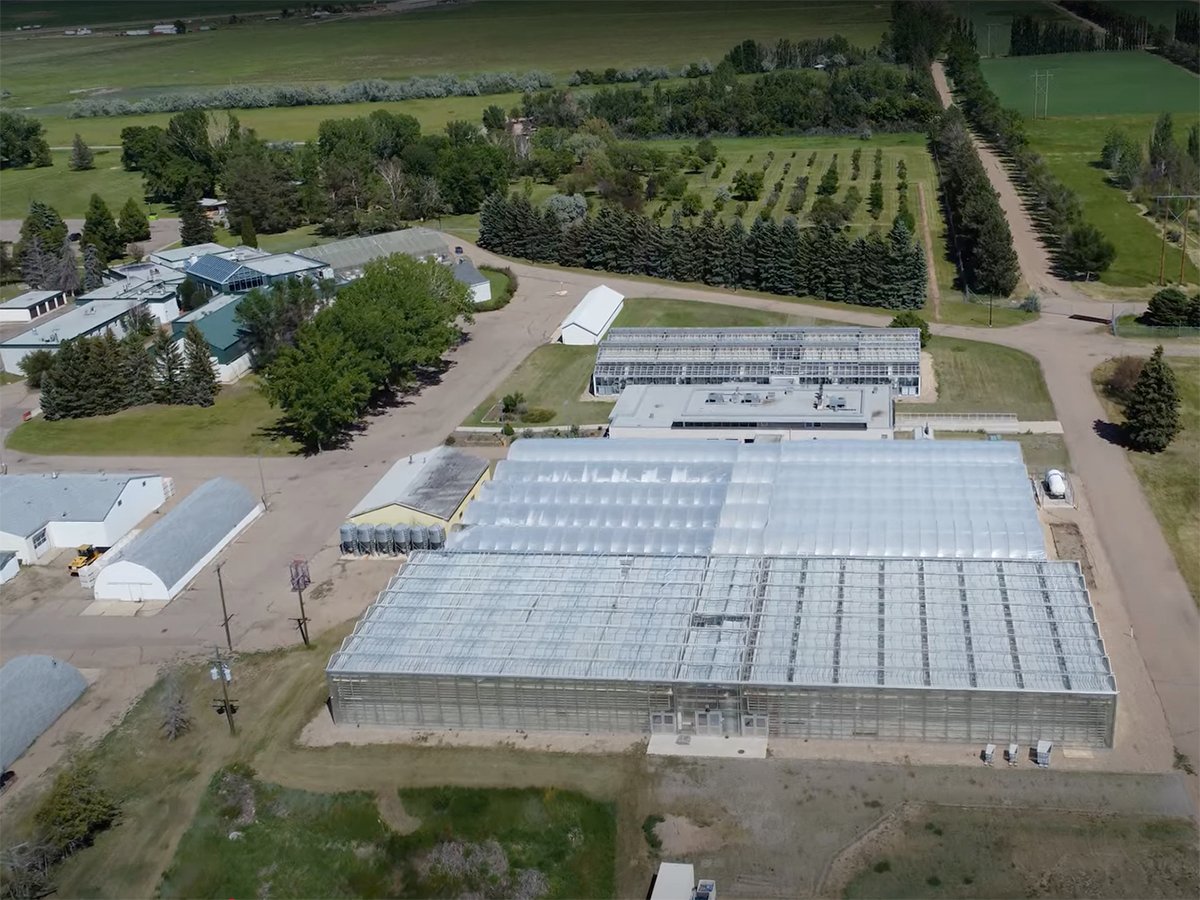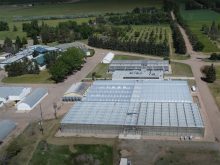If ignored, the allergic reaction of farmer’s lung can cause permanent lung damage. Early diagnosis is crucial if lasting damage is to be prevented. Because it is characterized by cold or flu-like symptoms, early detection is difficult. Many victims won’t even bother to visit a doctor despite persistent symptoms. When they do, the exposure to mouldy crop material is rarely mentioned to the physician. This can be disastrous, because each exposure increases the damage.
Moulds the cause
When crops are stored without sufficient drying, they begin to heat. Many kinds of mould grow in such environments. When a farmer works with such material — for example, when a bale of hay is broken open — the mould is released as part of a very fine dust. A farmer who is working indoors can inhale a large amount of this dust in a very short time.
Read Also

Alberta crop diversification centres receive funding
$5.2 million of provincial funding pumped into crop diversity research centres
Because the dust is so fine, it gets past defence systems in the nose and throat. When the dust reaches the inner parts of the lungs (called the alveoli), the lungs’ internal defence system takes over. In most cases, the dust is removed without damage. However, an allergy to the material develops in a few individuals. In other words, the body “assumes” that the mould is more dangerous than is really the case, and prepares to combat the intruders.
The first exposure in sensitive individuals only creates the allergy. Every subsequent exposure triggers an allergic reaction. The body’s immune system goes to work against the mould, producing symptoms that may resemble anything from a cold to pneumonia. Scar tissue (fibrosis) forms within the lungs. While cold-like symptoms may clear up, the fibrosis is permanent.
Lung damage may be too slight to notice in the early stages of farmer’s lung. However, each subsequent exposure increases tissue damage. A victim will soon begin to notice that he is short of breath. At first, this makes strenuous work more difficult. Even routine tasks become too much after frequent, repeated exposure. Eventually, the victim may find it a struggle to even get out of a chair.
Acute vs. chronic attacks
The allergic reactions of farmer’s lung are usually divided into either acute or chronic attacks. Acute reactions are most noticeable but, by being ignored, the chronic form can do more long-term damage.
Acute reactions occur when a farmer is especially sensitive and/or when there is very heavy exposure to mouldy dust. Symptoms of an acute attack develop four to eight hours after exposure. They resemble flu or even pneumonia — in extreme cases the victim may go into shock and die.
Symptoms of acute farmer’s lung include fever, chills, a dripping nose, an irritating and harassing cough, blood-streaked sputum, labored or difficult breathing, with a feeling of tightness in the chest, crackling breathing, muscular pain and depression.
It is easy to see why these symptoms could be mistaken for a case of the flu. That’s why milder attacks are often left to “run their course” without a visit to a doctor. In the more extreme cases, the need for hospital care becomes obvious.
Symptoms of an acute farmer’s lung attack usually decrease after 12 hours, but may linger for up to two weeks. Severe attacks can last as long as 12 weeks.
‘TODS’ resembles acute farmer’s lung
Working with dusty feed can produce another respiratory affliction, called Toxic Organic Dust Syndrome (TODS). It, too, is caused by exposure to very large amounts of dust. TODS symptoms are identical to those resulting from an acute farmer’s lung attack. However, TODS is not an allergic reaction. While anyone can get TODS (and can become very sick from this condition), most people recover completely. Having TODS does not damage your lungs, and does not increase the risk of getting TODS again.
Chronic type more dangerous
While acute attacks are most noticeable, the chronic form of farmer’s lung is more common. Gradual development often leads victims to dismiss the chronic form as something minor, like a nagging chest cold. This makes chronic farmer’s lung especially dangerous. By the time an affected farmer goes to the doctor and the disease is diagnosed, there can already be serious damage.
Chronic farmer’s lung results from repeated exposure to mouldy dust. The quantities of dust may be so small that the farmer is hardly aware of them.
Chronic farmer’s lung has several symptoms:
- Occasional fever and sweating at night.
- Progressively increasing shortness of breath.
- Chronic cough.
- Appetite depression and weight loss.
- Generalized aches and pains.
- Weakness, loss of energy.
- Depression.
What are the chances of getting farmer’s lung?
The risks are fairly small. Studies suggest that fewer than 10 percent of farmers, perhaps less than five percent, are at risk of developing this condition. However, there is no way of finding out in advance whether or not you are immune.
Risks increase when crops have been stored in damp or tough conditions. Working with such material outdoors poses minimal danger, because the mouldy dust is quickly dispersed. The greatest danger occurs during the months when mouldy crops are being handled indoors.
While farmer’s lung is usually associated with the handling of hay, any mouldy plant material can be responsible. The list includes grain, straw, silage and even tobacco. Uncapping a silo or cleaning out a grain bin usually releases large quantities of mouldy dust.
How to tell if you have it
If you experience any of the following, contact your doctor immediately: A sudden illness that develops a few hours after you have handled mouldy crop materials; a chronic cough; or a general feeling of tiredness or depression.
To help your doctor make an accurate diagnosis, emphasize that you have been exposed to dust from mouldy crops. A series of procedures, which might include a blood test, a chest X-ray, and a breathing capacity test may be used to confirm or disprove a tentative diagnosis.
Treatment
Farmer’s lung can be controlled, but it cannot be cured. In acute cases, the symptoms can be treated with bed rest and oxygen therapy. Medication can be used to control symptoms in chronic cases. This can be dangerous, however, because damage to the lungs may continue without the victim’s awareness.
The only proven treatment for chronic farmer’s lung victims is the avoidance of contact with mouldy crop materials. Just as there is no way of curing the allergy once it has developed, lung damage cannot be repaired.
In milder cases that are detected early, avoiding contact with the moulds will prevent further lung damage. In severe cases, the victim will have to quit farming.
Don’t take chances
There is no way of knowing in advance whether you are immune to the moulds that cause farmer’s lung. The only way to prevent this condition is to avoid contact with dust from mouldy plant material. While it is difficult to completely eliminate contact, there are several measures that will minimize exposure to the mouldy dust.
- Make sure that crops are adequately dried prior to storage. This is the key to stopping mould growth. Artificial drying systems and preservatives can prevent mould development.
- If possible, wet hay should be ensiled.
- When cleaning out grain bins or other areas that are likely to be dusty, wet them down first.
- Provide as much ventilation as possible when working in dusty areas. For example, make sure doors and windows are open. If practical, construct new openings to provide more ventilation.
- Move the work outdoors whenever possible. While this is usually not practical in the case of feeding operations, be sure to open bales that you know are mouldy outdoors.
- Avoid dusty work in confined areas. When constructing new farm buildings or modifying older structures, keep facilities as open as possible.
- When you have to work with mouldy material, try to keep your distance. If you have to break open a mouldy bale, do so with a fork, instead of bending over and using your hands.
- Mechanize feeding operations if economically feasible. For example, handling large round bales with a tractor keeps an operator away from the mouldy dust.
- In some cases, it is best to wear a respirator. Make sure that it is an approved toxic dust respirator. You must familiarize yourself with correct procedures for using and maintaining the respirator. It should never be used as an excuse for skipping other precautions.
Keeping it in check
Once a person has farmer’s lung, the only way to control it is to avoid all contact with mouldy dust. This means doubling the precautions listed above. If possible, any dusty work should be handled by someone other than the victim. Ignoring these precautions will lead to progressively more serious lung damage.
A farmer’s lung victim might have to quit farming in order to avoid becoming permanently disabled.














